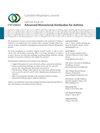Smoking Cessation by Phone Counselling in a Lung Cancer Screening Program: A Retrospective Comparative Cohort Study
IF 2.1
4区 医学
Q3 RESPIRATORY SYSTEM
引用次数: 0
Abstract
Introduction Smoking cessation integration within lung cancer screening programs is challenging. Currently, phone counselling is available across Canada for individuals referred by healthcare workers and by self-referral. We compared quit rates after phone counselling interventions between participants who self-refer, those referred by healthcare workers, and those referred by a lung cancer screening program. Methods This is a retrospective cohort study of participants referred to provincial smoking cessation quit line in contemporaneous cohorts: self-referred participants, healthcare worker referred, and those referred by a lung cancer screening program if they were still actively smoking at the time of first contact. Baseline, covariates (sociodemographic information, smoking history, and history of mental health disorder) and quit intentions (stage of change, readiness for change, previous use of quit programs, and previous quit attempts) were compared among the three cohorts. Our primary outcome was defined as self-reported 30-day abstinence rates at 6 months. Multivariable logistic regression was used to identify whether group assignment was associated with higher quit rates. Results Participants referred by a lung cancer screening program had low quit rates (12%, 95% CI: 5–19) at six months despite the use of phone counselling. Compared to patients who were self-referred to the smoking cessation phone helpline, individuals referred by a lung cancer screening program were much less likely to quit (adjusted OR 0.37; 95% CI: 0.17–0.8), whereas those referred by healthcare workers were twice as likely to quit (adjusted OR 2.16 (1.3–3.58)) even after adjustment for differences in smoking intensity and quit intentions. Conclusions Phone counselling alone has very limited benefit in a lung cancer screening program. Participants differ significantly from those who are otherwise referred by healthcare workers. This study underlines the importance of a dedicated and personalized tobacco treatment program within every lung cancer screening program. The program should incorporate best practices and encourage treatment regardless of readiness to quit.在肺癌筛查项目中通过电话咨询戒烟:一项回顾性比较队列研究
在肺癌筛查项目中整合戒烟是具有挑战性的。目前,加拿大各地对保健工作者介绍的个人和自我介绍的个人提供电话咨询。我们比较了自我推荐的参与者、由医护人员推荐的参与者和由肺癌筛查项目推荐的参与者在电话咨询干预后的戒烟率。方法:这是一项回顾性队列研究,参与者在同一时期的队列中被转介到省级戒烟线上:自我转介的参与者,卫生保健工作者转介的参与者,以及那些在第一次接触时仍在积极吸烟的肺癌筛查项目转介的参与者。基线、协变量(社会人口统计信息、吸烟史和精神健康障碍史)和戒烟意图(改变阶段、改变的准备程度、以前使用戒烟计划和以前的戒烟尝试)在三个队列中进行比较。我们的主要结局被定义为6个月时自我报告的30天戒断率。使用多变量逻辑回归来确定组分配是否与较高的戒烟率相关。结果:尽管使用电话咨询,肺癌筛查项目的参与者在六个月时的戒烟率很低(12%,95% CI: 5-19)。与自我咨询戒烟电话热线的患者相比,接受肺癌筛查项目咨询的患者戒烟的可能性要小得多(调整OR 0.37;95% CI: 0.17-0.8),而那些由卫生保健工作者转诊的人即使在调整了吸烟强度和戒烟意图的差异后,戒烟的可能性也是两倍(调整OR 2.16(1.3-3.58))。结论:在肺癌筛查项目中,仅电话咨询的益处非常有限。参与者与那些由卫生保健工作者转诊的人有显著差异。这项研究强调了在每一个肺癌筛查项目中一个专门的和个性化的烟草治疗项目的重要性。该计划应纳入最佳做法,并鼓励治疗,无论是否准备戒烟。
本文章由计算机程序翻译,如有差异,请以英文原文为准。
求助全文
约1分钟内获得全文
求助全文
来源期刊

Canadian respiratory journal
医学-呼吸系统
CiteScore
4.20
自引率
0.00%
发文量
61
审稿时长
6-12 weeks
期刊介绍:
Canadian Respiratory Journal is a peer-reviewed, Open Access journal that aims to provide a multidisciplinary forum for research in all areas of respiratory medicine. The journal publishes original research articles, review articles, and clinical studies related to asthma, allergy, COPD, non-invasive ventilation, therapeutic intervention, lung cancer, airway and lung infections, as well as any other respiratory diseases.
 求助内容:
求助内容: 应助结果提醒方式:
应助结果提醒方式:


